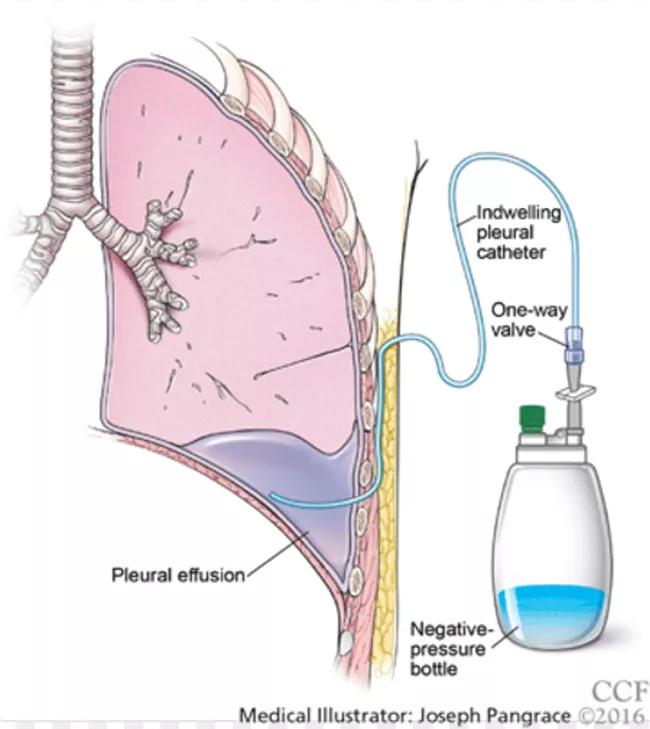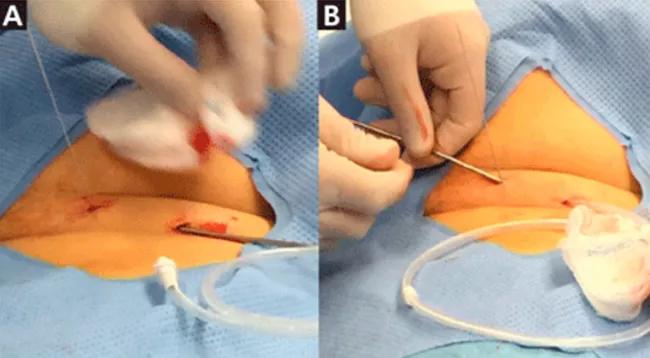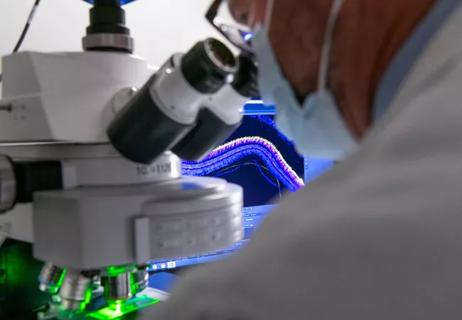Advertisement
Shorter hospital stay, less risk for reintervention

By Thomas Gildea, MD, MS, FCCP
Advertisement
Cleveland Clinic is a non-profit academic medical center. Advertising on our site helps support our mission. We do not endorse non-Cleveland Clinic products or services. Policy
An indwelling pleural catheter should be considered when a malignant pleural effusion causes symptoms and recurs after thoracentesis, especially in patients with short to intermediate life expectancy or trapped lung, or who underwent unsuccessful pleurodesis.
Malignant pleural effusion affects about 150,000 people in the United States each year. It occurs in 15 percent of patients with advanced malignancies, most often lung cancer, breast cancer, lymphoma and ovarian cancer, which account for more than 50 percent of cases.
In most patients with malignant pleural effusion, disabling dyspnea causes poor quality of life. The prognosis is unfavorable, with life expectancy of three to 12 months.
In general, management focuses on relieving symptoms rather than on cure. Symptoms can be controlled by thoracentesis, but if the effusion recurs, the patient needs repeated visits to the emergency room or clinic or a hospital admission to drain the fluid. Frequent hospital visits can be grueling for a patient with a poor functional status, and so can the adverse effects of repeated thoracentesis. For that reason, an early palliative approach to malignant pleural effusion in patients with cancer and a poor prognosis leads to better symptom control and a better quality of life. Multiple treatments can be offered to control the symptoms in patients with recurrent malignant pleural effusion.
Advertisement
Pleurodesis has been the treatment of choice for malignant pleural effusion for decades. In this procedure, adhesion of the visceral and parietal pleura is achieved by inducing inflammation either mechanically or chemically between the pleural surfaces. Injection of a sclerosant into the pleural space generates the inflammation. The downside of this procedure is that pleural effusion recurs in 10 to 40 percent of cases, and patients require two to four days in the hospital. Also, the use of talc can lead to acute lung injury—acute respiratory distress syndrome, a rare but potentially life-threatening complication.
Indwelling pleural catheters are currently used as palliative therapy for patients with recurrent malignant pleural effusion who suffer from respiratory distress due to rapid reaccumulation of pleural fluids that require multiple thoracentesis procedures.
An indwelling pleural catheter is contraindicated in patients with uncontrolled coagulopathy, multiloculated pleural effusions, or extensive malignancy in the skin.

Draining of a pleural effusion in the left hemi-thorax. The indwelling pleural catheter is tunneled under the soft tissue and enters the thoracic cavity between the ribs. Proximally, the catheter has a one-way valve and evacuates into a negative-pressure bottle.
Catheters are 66 cm long and 15.5F and are made of silicone rubber with fenestrations along the distal 24 cm. They have a one-way valve at the proximal end that allows fluids and air to go out but not in.
The catheter is inserted and tunneled percutaneously with the patient under local anesthesia and conscious sedation. Insertion is a same-day outpatient procedure, and intermittent pleural fluid drainage can be done at home by a home healthcare provider or a trained family member.

Tunneling the indwelling pleural catheter under the soft tissue of the chest wall before insertion in the pleural cavity. The procedure can be performed at the bedside under sterile conditions. The site of the insertion is identified with thoracic ultrasonography. (A) The guide wire is inserted at the thoracic inlet area, then (B) the catheter is tunneled under the skin to the guide wire area for insertion.
In a meta-analysis, insertion difficulties were reported in only 4 percent of cases, particularly in patients who underwent prior pleural interventions. Spontaneous pleurodesis occurred in 45 percent of patients at a mean of 52 days after insertion.
Advertisement
After catheter insertion, the pleural space should be drained three times a week. No more than 1,000 mL of fluid should be removed at a time—or less if drainage causes chest pain or cough secondary to trapped lung (see below). When the drainage declines to 150 mL per session, the sessions can be reduced to twice a week. If the volume drops to less than 50 mL per session, imaging is recommended to ensure the achievement of pleurodesis and to rule out catheter blockage.
A large, multicenter, randomized controlled trial compared indwelling pleural catheter therapy and chest tube insertion with talc pleurodesis. Both procedures relieved symptoms for the first 42 days, and there was no significant difference in quality of life. However, the median length of hospital stay was four days for the talc pleurodesis group compared with zero days for the indwelling pleural catheter group. Twenty-two percent of the talc group required a further pleural procedure, compared with 6 percent of the indwelling catheter group. On the other hand, 36 percent of those in the indwelling catheter group experienced nonserious adverse events such as catheter blockage, compared with 7 percent of the talc group.
In another multicenter pilot study, rapid pleurodesis was achieved in 30 patients with recurrent malignant pleural effusion by combining chemical pleurodesis and indwelling catheter placement. Pleurodesis succeeded in 92 percent of patients by day eight after the procedure. The hospital stay was reduced to a mean of two days after the procedure. In the catheter group, fluids were drained three times in the first day after the procedure and twice a day on the second and third days.
Placement of an indwelling pleural catheter is an effective initial treatment for recurrent malignant pleural effusion. Compared with chemical pleurodesis, it has a comparable success rate and complication rate. It offers the advantages of being a same-day surgical procedure entailing a shorter hospital stay and less need for further pleural intervention. This treatment should be considered for patients with symptomatic malignant pleural effusion, especially those in whom symptomatic malignant pleural effusion recurred after thoracentesis.
Dr. Gildea heads the Section of Bronchoscopy in the Respiratory Institute.
This article has been edited for length and originally appeared in Cleveland Clinic Journal of Medicine.
Advertisement
Advertisement

A review of IDSA and NIH guidelines

Caregivers are provided with real-time bronchoscopy patient findings

New program sets out to better support underserved patient populations

As the U.S. has seen an increase in respiratory-related morbidity and mortality, supporting future respiratory researchers has become imperative

Diagnosing the cause of a chronic cough can be challenging and timely, but multidisciplinary collaboration and the development of new treatments are improving the process

Despite a decline in numbers, the demand for respiratory therapists continues to rise

A mindset shift has changed the way pulmonologists both treat and define PFF

Will enable patients with long COVID to enroll in national clinical trials